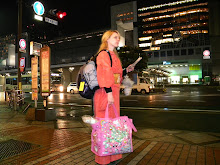
"How do you spell 'terrifying,'?" Katie asks, as we both sprawl across our beds at the Ganpati and write in our journals.
"Just a sec," I reply, flipping the page back in my own diary. "Let me see how I spelled it."
Before arriving in India, I was content in the delusion that, on the whole, I was a brave person. Sure, there are some things in life I’ve always found frightening -- heights (or, more specifically, activities in which one might fall from a great height), tornadoes (ever since I raced one home along empty, rain-slick back roads in Ohio), and casseroles (you just never know what might be inside one) -- but these are universal concerns, I reckon. It isn’t actually until I am in Varanasi that I can fully appreciate the unique depth and breadth of my fears. As it turns out, I am also afraid of:
1. Cows

As someone who grew up in rural Ohio, cows should not be a big deal to me. But in India, they are a ubiquitous presence on the streets, by the temples, grazing on garbage just outside the shops. I even see a couple of cows slowly walking sideways down a steep flight of steps to the Ganges.
Now generally, cattle are docile creatures, leading placid lives dedicated to the fine arts of eating and pooping. However, at one point during our time in Varanasi, Katie and I turn down the very narrow lane leading to our guesthouse only to encounter three cows running toward us. They have long, pointed horns. Perhaps they are bulls. We don’t stop to check.
"I think we can find another way to the guesthouse," Katie gasps, and we quickly turn and run back down the alley. It is like our own, low-budget version of Pamplona's running of the bulls.
2. Monkeys

At the Monkey Temple, there must be hundreds of monkeys running about. They look absolutely adorable. Except for the ones that attack people.
“What if a monkey bites me?” I’d asked a young Indian man before setting out for the temple.
“Don’t worry,” he said, “The monkeys can see if you have a pure heart and will not harm you.”
While Katie and I walk through the temple grounds, one of the larger monkeys voraciously consumes a necklace strung with bright orange marigolds, an offering someone had left on the temple’s altar. I walk a few steps closer to get a better look.
“How cute!” I coo.
The monkey snarls, showing a set of small, pointy teeth, and fakes a lunge at me.
“You have evil in your heart,” Katie chastises.
As we are leaving the temple, we witness another monkey throwing itself onto the silky folds of a woman’s sari. She shakes her skirts and dances, but it hisses and refuses to relinquish its grasp. That is the moment I know: Monkeys are scary, those damn dirty apes.
3. Beggars

In the Delhi airport, just before customs, is a wall which showcases a row of giant copper hands that have been beautifully molded into a variety of mudras, gestures used in traditional Indian dance. A more accurate representation of India, from my experience, would be a row of empty hands reaching out for money.
It seems there is always someone in India coming towards us with an outstretched hand. “Karma!” some of them angrily demand. But they all scare me and I refuse to give them money. I imagine this is not such a problem for people who actually live in India or visit less touristy places, but in Varanasi, Katie and I may as well have our foreheads tattooed with “Many Rupees.” One man, upset we didn’t give him money, protests by saying, “But you’re American. You’re rich.”
In contrast, we notice that the multitude of Korean tourists in India is routinely ignored by beggars and touts. Whenever I tell people I live in Korea, they respond with slight patronage: “Oh, it’s nice for a developing nation.” The wages Katie and I get from our workplaces in Korea put us in the same economic range as well-educated Koreans. But in India, everyone is adamant that Americans are rich and Koreans are poor.
Katie ponders buying a novelty t-shirt that reads, “No tour guide, No one rupee, No come to my shop.”
“Do you think it will work?” she asks hopefully.
4. Traffic

The traffic in India is amazing, in a sort of terrifying way. Katie sometimes closes her eyes as our rickshaw lurches down the street. We’re in the back of a two person bicycle rickshaw, but the problem is that it was really designed for two very skinny people, such as two small children, or maybe one medium-sized child and a puppy. At any rate, it fits us in a one-and-a-half person sort of way, and every time the rickshaw falls into and bounces out of a pothole, we partially levitate from the seat. Besides the danger of potential ejection from the rickshaw, there are cars, trucks, electric rickshaws, more bicycle rickshaws, pedestrians, cows, and dogs bearing down on us from every imaginable side and angle. I watch in fascinated horror. How are we not dead yet?
“How can you stand to watch?” Katie asks.
“It’s exciting, like an amusement park ride . . . one that might kill you,” I explain.
5. Everyone in India Over the Age of 12

Varanasi is a pushing, pulling mass of people, the majority of whom constantly demand money, attention, a visit to their shops. Also, everywhere we go, no matter how modest our dress, men stare at us with blank, unreadable faces. When we sit across from them on the trains, they watch us like we are a movie. During one overnight train ride, Katie claims that the man in the bunk across from her is watching her the entire night. Every time she wakes up and looks around, he is already awake and staring at her.
My fear expands from simply being afraid of beggars to being afraid of everyone over the age of 12. The children, however, with their dark, bright eyes and ready smiles, charm me.
I tell Katie how to spell “terrifying.” I then confess to all the things which I find terrifying.
“Still braver than me,” Katie responds. “I’m also afraid of the kids.”



Oh god yes, totally! I still want to believe I'm brave after 17 years of travel and expattery and whatnot (shouldn't I be by now?) but I'm not-- and for most of the reasons you gave. And it wasn't just India- a month ago I was in Cambodia and, yes, I learned I had evil in my heart: I was actually BIT by a temple monkey in Phnom Penh, thus confirming my suspicions that I really had reason to fear monkeys (a fear started in India five years ago, in fact!). $1500 worth of immunoglobulin and rabies shots over the next fortnight doubly confirmed my suspicions that there were indeed things I feared. (Here's my blogpost on that fun, if you need to confirm the logic behind your fear: http://tinyurl.com/4oeq2w2 )
ReplyDeleteIn Shanghai, I still fear traffic, especially buses, as they don't signal or even look when veering into your lane, and they have a fondness for running red lights, much like Sandra Bullock in Speed, except on a daily basis.
@MaryAnne -- Your comments are so funny! And that story only reconfirms my belief that monkeys are bad news. I mean, I love monkeys when they are in the form of a cup, stuffed animal, or cartoon movie, but monkeys in real life are just not my thing.
ReplyDeleteYou should travel with male company. India isn't safe for female tourists.
ReplyDelete